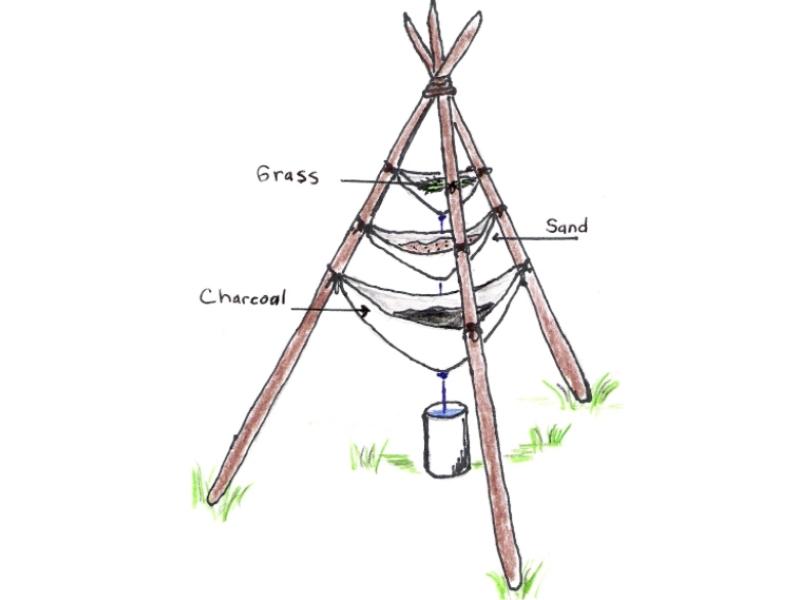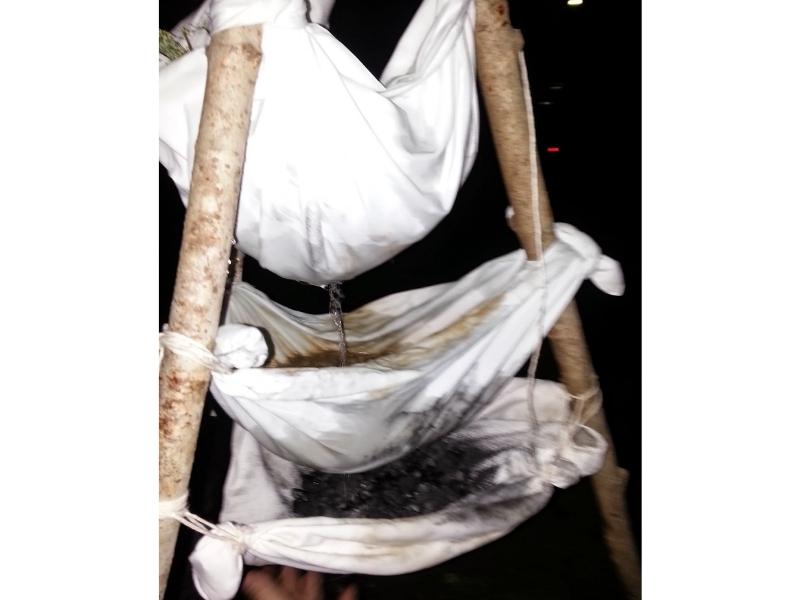SHTFPreparedness may collect a share of sales or other compensation from the links on this page.
When you are out in the wild you may find you are short on safe drinking water. Drinking contaminated water can lead to a range of health issues. Many water borne diseases can be life threatening so it is not worth taking the risk on unfiltered water.
Often when you have found water in nature it may contain bigger contaminants including sand particles from riverbeds and other naturally occurring items like twigs and leaves.
Having some sort of filtration process will be essential in order to make the water safe for consumption. There are plenty of water filters that you can buy that could work for filtering water that has smaller particles or contaminants.
However in general these types of filters will be clogged up with bigger particles that you may find in a natural water source. This is where the tripod water filter can come in.
DIY Tripod Water Filter

This DIY water filter can handle filtering out the bigger particles and leave you with a more manageable water consistency that can then be finally filtered by boiling the water into safe drinking water once it is cooled or using any other filtration method or device you would prefer.
Without the tripod filter the boiling would not make the water safe for consumption. The tripod water filter is simple to make and useful for when things go wrong and you are forced to use a water source that needs filtration.
All you need to build your own tripod water filter is:
- 3 sticks about 3-4 feet long
- 3 pieces of triangular cloth (preferably cotton if possible)
- Green plants like fern (green plants that are not poisonous or that will give the water an odd taste)
- Crushed black charcoal from the fire (not the ash)
- Clean sand
- A knife or sharp object,
- Rope or paracord
To assemble your tripod water filter:
- Take your 3 sticks and sharpen one end of each stick using your knife or sharp object in order to be able to put them securely into the ground.
- Tie together the non sharp ends of your sticks into a tripod shape with your rope or paracord and then put the sharp ends into the ground.
- Use your 3 pieces of cloth to build the layers of your filter. Tie each corner to the sticks to build one layer. Make sure you have 3 layers in your filter.
- Once your material layers are secure then add the filtration substances to each layer.
- Layer 1 is on the top and you should add your safe green plant material here. This should cover the majority of the cloth area for the water to pass through.
- Layer 2 is the next layer below. This should be the coal from your fire that covers the majority of the 2nd cloth layer.
- Layer 3 is the bottom layer. This is where you add the clean sand that covers the majority of the final cloth layer.
Your tripod water filter is now assembled. It is ready to be used once you have your water that needs to be filtered. This filter can be easily moved and broken down to be used somewhere else if you are on the move.
Using Your Tripod Water Filter Correctly

Like with many filters using the tripod water filter the first time will require “breaking it in” before it will be fully functional. Initially you will not want to catch the water that comes through the first few passes through the filter.
This is to get rid of any bigger particles of coal and any mud or clay from your sand layer. Once the water that comes through the 3rd layer starts looking clear you can begin to collect your water.
It is important to remember that the water you are collecting is not safe to drink; it is just now free of the larger particles and contaminants.
This is a type of pre filter that will now allow you to use a store bought filter and allow it to last longer as it will not get clogged up. You can also boil the filtered water to make it safe for drinking if you have no other option for filtration.
Advantages To Using The Tripod Water Filter
There are a number of advantages to using this filter including:
- The filter is made with natural materials and some cloth so it is really versatile and easy to put together. If you find yourself out in the wild with limited resources this is a viable filter option to use.
- The tripod water filter is portable. You just remove the filter materials (which are easy to replace) , pick up your tripod with cloths and move it to the new location where you will need it and set it up again in minutes.
- It is a good option to improve the overall quality and taste of the naturally found water provided you use the correct materials.
Disadvantages To Using The Tripod Water Filter
Everything comes with pros and cons and this filter has some disadvantages as well:
- Depending on the environment you find yourself in you may not be able to find all the items needed to build this filter. For example if you are in a drier region you may not be able to find the greens needed for your first layer in the filter.
- While this filter is a good pre-filter option it essentially only removes larger particles and it does not remove pathogens. It requires a further filtration stage to remove smaller contaminants to make it safe for consumption.
- The charcoal needed for your second layer will not naturally be available in the wild. If you happen to have some of your own then this will be fine or if you happen to find remnants of someone else’s fire. If not for these 2 scenarios you could be missing one of your layers.
Final Thoughts
No solution is perfect when it comes to filtration but the tripod water filter is definitely a useful one to have in your repertoire should SHTF.
This is a great pre-filter option for naturally found water that contains larger particles and would clog up a regular filter.
While you still need another stage of filtering with the tripod water filter is still a very necessary step in the full filtration process to get you safe drinking water and a good one to know how to put together.